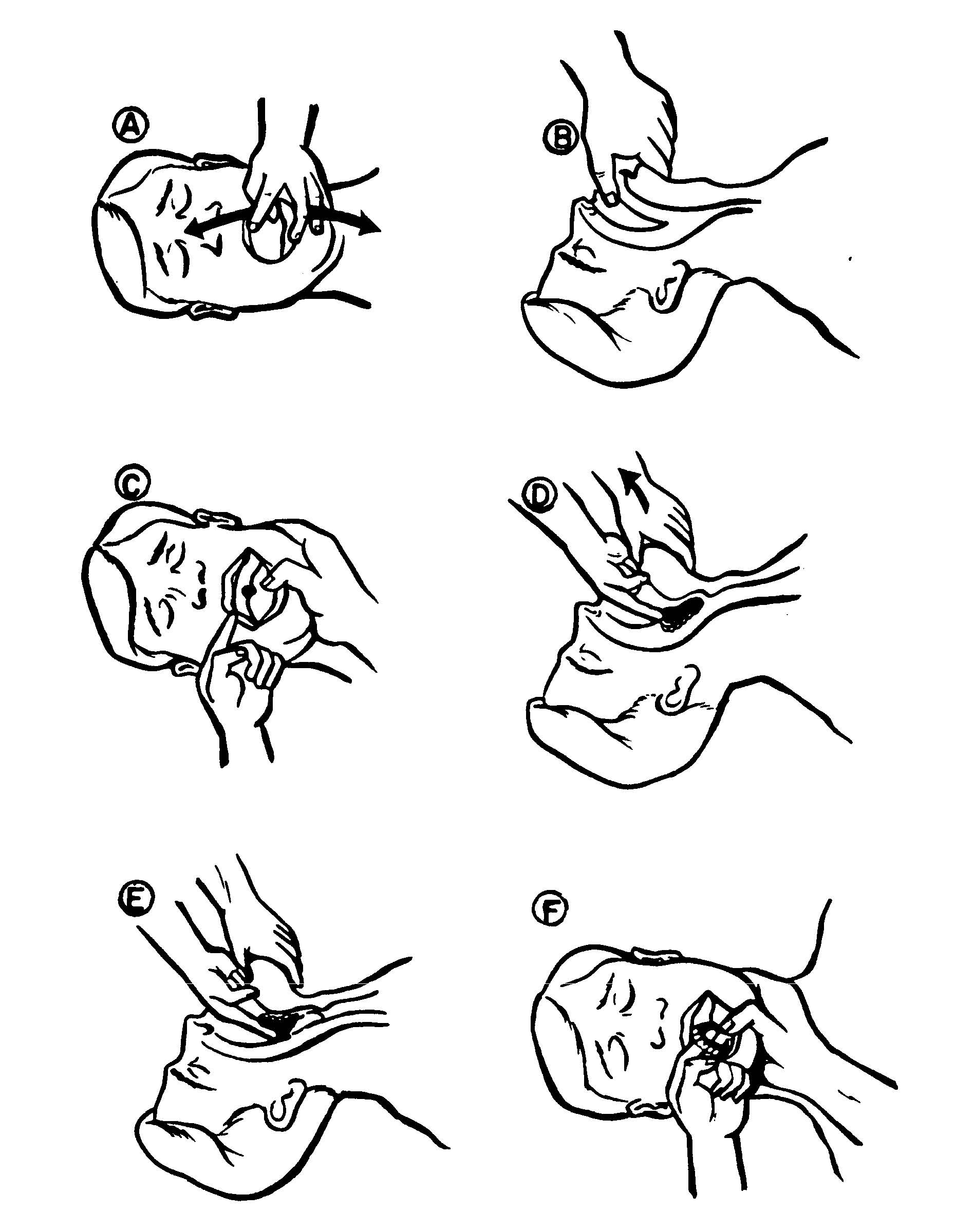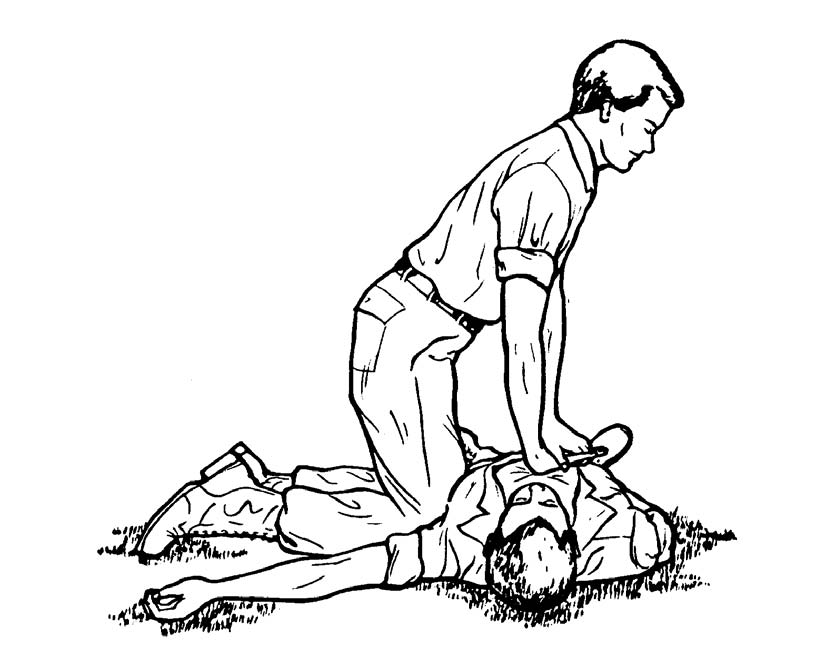Cardiopulmonary Resuscitation
LESSON 5: Remove an Upper Airway Obstruction in an Adult
5-6
5-6. REMOVE AN AIRWAY OBSTRUCTION IN AN UNCONSCIOUS CASUALTY OR A CASUALTY WHO IS LYING ON HIS BACK
The procedures given in this paragraph are used to expel an airway obstruction when a casualty with poor air exchange or complete blockage is conscious and lying down, when a standing or sitting casualty becomes unconscious during efforts to expel the obstruction, or when an obstruction is discovered during an attempt to perform rescue breathing or CPR.
a. Position Casualty. Place the casualty on a flat, hard surface in a supine (on his back) position if he is not already in this position.
b. Call for Help. If you have not already sent for help, send someone to get additional medical help.
c. Administer Finger Sweep. A finger sweep is performed in an attempt to remove blockage. Finger sweeps are performed only if the casualty is unconscious. Manual thrusts may dislodge an object which could not be reached when you began your rescue efforts. When you can remove a foreign object from a casualty's mouth, do so. Care must be used in helping a conscious casualty remove an object from his mouth because your actions may trigger his "gag reflex." Do not use the finger sweep technique with a conscious casualty. The procedures for performing a finger sweep are given below and in figure 5-5.
A Cross-finger method of opening mouth. B Tongue-jaw lift.
C Inserting finger. D Sweeping motion.
E Trapping obstruction. F Removing obstruction.
Figure 5-5. Performing a finger sweep on an unconscious casualty.
(1) Position the casualty's head so that his face is up.
(2) Open the casualty's mouth. If the casualty's mouth does not open readily, use the crossed-finger method of opening the mouth.
(a) Cross the index finger and thumb of one hand.
(b) Place the tip of the thumb and the tip of the index finger against opposite sets of teeth on the cutting or grinding edge of the teeth.
(c) Slide the thumb and index finger across each other in opposite directions to separate the upper and lower teeth and open the casualty's mouth.
(3) Open the casualty's airway by grasping his tongue and lower jaw between your thumb and finger and lifting the tongue and jaw. This procedure, called the tongue-jaw lift, moves the tongue away from the back of the casualty's throat. By lifting the tongue and jaw, the
casualty's airway is opened further and foreign objects are easier to locate. In addition, repositioning the casualty's tongue and jaw may loosen an object in the airway enough to allow air to move past it.
(4) Look into the casualty's mouth to see if you can locate the object causing the blockage. Perform the finger sweep even if you cannot visually locate the object.
(5) Insert the index finger of your free hand along the inside of the casualty's cheek down to the base of his tongue.
(6) Sweep the throat with a "hooking" motion. A foreign object may be dislodged as you move your finger from the side of his throat toward the center. You may need to push the object to the side of the throat and trap it before removing the object. Be sure that you do not force the
object deeper into the airway. If the casualty is wearing dentures, remove the dentures if they interfere with sweeping the mouth.
(7) If an object is located and can be removed, lift the object with your "hooking" finger and remove the object from the casualty's throat and mouth.
d. Administer Two Ventilations. After performing the finger sweep, open the casualty's airway using the head-tilt/chin-lift or jaw-thrust (paragraph 3-6) and attempt to administer two full breaths (paragraph 3-9). This procedure should take between 3 to 5 seconds.
(1) If your attempts to ventilate are successful, check for spontaneous breathing. If the casualty does not breathe on his own, perform rescue breathing or CPR as appropriate.
(2) If your attempts are not successful (chest does not rise), reposition the airway and try to ventilate the casualty again.
(a) If your second attempt to ventilate is successful, check for spontaneous breathing. If the casualty does not breathe on his own, perform rescue breathing or CPR if needed.
(b) If your attempts are still not successful, the airway is still being blocked. Call again for help (if appropriate) and proceed to administer modified abdominal or modified chest thrusts.
e. Maintain Airway. Adjust the casualty's head so that it is face up and the airway is open. If an assistant is present, have him keep the casualty's airway open using the head-tilt/chin-lift or jaw-thrust method, as appropriate.
f. Administer Modified Manual Thrusts. Manual thrusts are performed in an attempt to expel the object blocking the casualty's airway. The procedures for administering abdominal and chest thrusts given in paragraph 5-5c must be modified since the casualty is now lying on his back. Each thrust is delivered with the aim of expelling the obstruction without having to administer additional thrusts. Administer modified abdominal thrusts unless the casualty is in the latter stages of pregnancy, the casualty has abdominal injuries, or the casualty is so overweight that abdominal thrusts will not be effective. If one of these conditions exists, administer modified chest thrusts.
(1) Abdominal thrusts.
(a) Straddle the casualty's thighs. If the casualty is larger than you, it may be necessary to straddle only one of his thighs.
(b) Place the heel of one hand against the casualty's abdomen on the midline slightly above his navel and well below his xiphoid process. (This is the same location as for the standing abdominal thrust.)
(c) Place your other hand on top of the hand on the casualty's abdomen. Fingers can be interlaced or extended away from your body.
(d) Press down with an inward and upward thrust (figure 5-6). Keep your arms straight and do not push to either side. Use your body weight to help you perform the thrust. After the thrust, release the pressure on the abdominal area by leaning back.
NOTE: If the thrust causes the casualty to vomit, turn his head to one side and clear the vomitus from his mouth. Then check the casualty for breathing. If
additional thrusts are needed, reposition the casualty's head so his face is in
the up position and his airway is open.)
Figure 5-6. Administering a modified abdominal thrust to an unconscious casualty.
(e) Repeat the modified abdominal thrusts until the obstruction has been expelled or until 5 thrusts have been administered.
(2) Chest thrust.
(a) Position yourself at the side of the casualty's chest.
(b) Locate the compression site by running two fingers along the lower edge of the rib cage toward the center of his chest until you come to the notch, placing the tip of your lower finger in the notch, placing your other hand next to and above the first finger, and placing the heel of your other hand next to and above the upper finger. The heel is now over the lower half of the sternum and covers the compression site. This is the same site used in administering CPR chest compressions (see figure 4-1). Make sure the long axis of your hand is parallel to the sternum.
(c) Place the heel of the other hand on top of the hand over the compression site. Make sure that the heel on bottom is not resting on any ribs. The fingers of the bottom hand should be straight. The fingers of the top hand should either be straight or be interlaced with the fingers of the first hand. Keep your fingers and palms off the casualty's chest.
(d) Lean forward so your shoulders are over your hands. Keep your arms straight.
(e) Thrust straight down on the lower half of the casualty's sternum (figure 5-7). Keep both arms straight and do not thrust to the right or left. The thrust should compress the sternum 1 1/2 to 2 inches in an adult casualty. Release the pressure by leaning back and away from the chest.
Figure 5-7. Administering a modified chest thrust to an unconscious casualty.
(f) Repeat the modified chest thrusts until the obstruction has been expelled or until 5 thrusts have been administered.
g. Administer Two Ventilations. After expelling the object or after performing 5 modified abdominal or chest thrusts, open the casualty's airway and attempt to administer two full breaths (paragraph 3-9).
(1) If your attempts to ventilate are successful, check for spontaneous breathing. If the casualty does not resume breathing on his own, perform rescue breathing or CPR as appropriate.
(2) If your attempts are not successful (chest does not rise), continue to perform finger sweeps and modified thrusts until you are able to ventilate the casualty or until you are told to stop your efforts by a qualified person.




